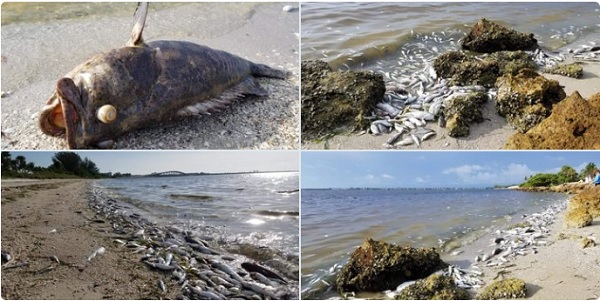The ongoing toxic algae bloom is considered to be the longest red tide outbreak for the Gulf of Mexico in over a decade, and officials say it will most likely last until 2019.
High concentrations of toxic algae, known as blooms, have affected at least 120 miles of the peninsula’s Gulf of Mexico coast since November 2017.
Dolphins, manatees and even a whale shark have washed up dead on the Gulf of Mexico beaches due to the “red tide”, according to Florida locals.
Key points:
- Social media is inundated with images of dead animals
- Toxic bloom washes up on the Gulf of Mexico beaches across Florida
- 160.9 kilometres of coastline has been affected so far, CNN says
Red tide is the name given to the blooms of a species of microorganisms that have a distinct red colour.
The bloom is an annual event in the waters around Florida and it usually breaks up with the wind and tide; but according to local reports, the current bloom has lasted for up to nine months and has killed more marine life than usual.
It is believed a combination of coastal pollution and nutrient-laden water being flushed into the warm waters of the gulf from Lake Okeechobee have caused the particularly severe red tide.
Social media has been inundated with images of dead animals that failed to escape the toxic bloom washing up on the Gulf of Mexico beaches across Florida.
WINK-TV News meteorologist Matt Devitt posted images on his Facebook page of fish, stingrays, manatees, turtles and a whale shark that had died.
“Pictures are recent and within July, most from Lee County,” he wrote.
“We’ve also had issues for Collier, Charlotte, and Sarasota counties too.”
According to US network CNN, this year’s effect of the red tide on marine life has been unprecedented.
The news agency said about 160.9 kilometres of coastline had been affected so far.
“It’s hard to predict more than a few days out [when it will end],” Florida Fish and Wildlife Conservation Commission spokeswoman Michelle Kerr told CNN.
‘It needs to be a wake-up call’
Red tide is not the only algae outbreak that has killed marine life in Florida, with a blue-green algae bloom — that started in Lake Okeechobee — poisoning freshwater rivers in the region.
According to reports, the US Army Corps of Engineers released water from the lake which had poisoned waterways downstream.
The Miami Herald reported the blue-green algae outbreak had grabbed national attention.
PHOTO: A whale shark washed up on Sanibel Island in south-west Florida. (Facebook: Matt Devitt)
TYT Newsroom with information from:
- http://www.abc.net.au
- https://www.accuweather.com/





